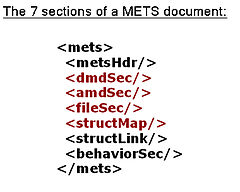
The Dublin Core, also known as the Dublin Core Metadata Element Set (DCMES), is a set of fifteen main metadata items for describing digital or physical resources. The Dublin Core Metadata Initiative (DCMI) is responsible for formulating the Dublin Core; DCMI is a project of the Association for Information Science and Technology (ASIS&T), a non-profit organization.

Extensible Markup Language (XML) is a markup language and file format for storing, transmitting, and reconstructing arbitrary data. It defines a set of rules for encoding documents in a format that is both human-readable and machine-readable. The World Wide Web Consortium's XML 1.0 Specification of 1998 and several other related specifications—all of them free open standards—define XML.

The Geography Markup Language (GML) is the XML grammar defined by the Open Geospatial Consortium (OGC) to express geographical features. GML serves as a modeling language for geographic systems as well as an open interchange format for geographic transactions on the Internet. Key to GML's utility is its ability to integrate all forms of geographic information, including not only conventional "vector" or discrete objects, but coverages and sensor data.
MARC is a standard set of digital formats for the machine-readable description of items catalogued by libraries, such as books, DVDs, and digital resources. Computerized library catalogs and library management software need to structure their catalog records as per an industry-wide standard, which is MARC, so that bibliographic information can be shared freely between computers. The structure of bibliographic records almost universally follows the MARC standard. Other standards work in conjunction with MARC, for example, Anglo-American Cataloguing Rules (AACR)/Resource Description and Access (RDA) provide guidelines on formulating bibliographic data into the MARC record structure, while the International Standard Bibliographic Description (ISBD) provides guidelines for displaying MARC records in a standard, human-readable form.
The Open Archives Initiative Protocol for Metadata Harvesting (OAI-PMH) is a protocol developed for harvesting metadata descriptions of records in an archive so that services can be built using metadata from many archives. An implementation of OAI-PMH must support representing metadata in Dublin Core, but may also support additional representations.
Encoded Archival Description (EAD) is a standard for encoding descriptive information regarding archival records.
RDFa or Resource Description Framework in Attributes is a W3C Recommendation that adds a set of attribute-level extensions to HTML, XHTML and various XML-based document types for embedding rich metadata within Web documents. The Resource Description Framework (RDF) data-model mapping enables its use for embedding RDF subject-predicate-object expressions within XHTML documents. It also enables the extraction of RDF model triples by compliant user agents.
The AgMES initiative was developed by the Food and Agriculture Organization (FAO) of the United Nations and aims to encompass issues of semantic standards in the domain of agriculture with respect to description, resource discovery, interoperability, and data exchange for different types of information resources.
Geospatial metadata is a type of metadata applicable to geographic data and information. Such objects may be stored in a geographic information system (GIS) or may simply be documents, data-sets, images or other objects, services, or related items that exist in some other native environment but whose features may be appropriate to describe in a (geographic) metadata catalog.
PREservation Metadata: Implementation Strategies (PREMIS) is the de facto digital preservation metadata standard.

Metadata is "data that provides information about other data", but not the content of the data itself, such as the text of a message or the image itself. There are many distinct types of metadata, including:
A metadata standard is a requirement which is intended to establish a common understanding of the meaning or semantics of the data, to ensure correct and proper use and interpretation of the data by its owners and users. To achieve this common understanding, a number of characteristics, or attributes of the data have to be defined, also known as metadata.
The Publishing Requirements for Industry Standard Metadata (PRISM) for the Internet, computing, and computer science, is a specification that defines a set of XML metadata vocabularies for syndicating, aggregating, post-processing and multi-purposing content.
Analyzed Layout and Text Object (ALTO) is an open XML Schema developed by the EU-funded project called METAe.
In computing, a data definition specification (DDS) is a guideline to ensure comprehensive and consistent data definition. It represents the attributes required to quantify data definition. A comprehensive data definition specification encompasses enterprise data, the hierarchy of data management, prescribed guidance enforcement and criteria to determine compliance.

The Journal Article Tag Suite (JATS) is an XML format used to describe scientific literature published online. It is a technical standard developed by the National Information Standards Organization (NISO) and approved by the American National Standards Institute with the code Z39.96-2012.
Lightweight Information Describing Objects (LIDO) is an XML schema for describing museum or collection objects. Memory institutions use LIDO for “exposing, sharing and connecting data on the web”. It can be applied to all kind of disciplines in cultural heritage, e.g. art, natural history, technology, etc. LIDO is a specific application of CIDOC CRM.

In archives, the term "audiovisual" is frequently used generically to denote materials other than written documents. Films, videos, audio recordings, pictures, and other audio and visual media are collected in audiovisual archives. A vast amount of knowledge is included in audiovisual records, which are considered cultural treasures and must be preserved for future use. Print materials would not have the same reach across various audiences as audiovisual resources.






